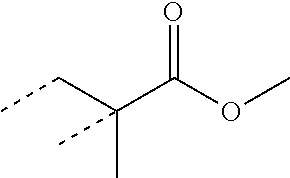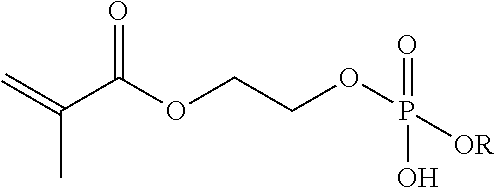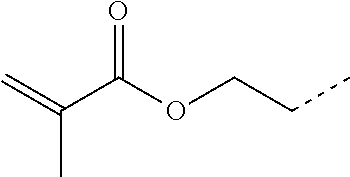Dispersion of adsorbing emulsion polymer particles
- Summary
- Abstract
- Description
- Claims
- Application Information
AI Technical Summary
Benefits of technology
Problems solved by technology
Method used
Image
Examples
example 1
Preparation of Styrene-Acrylic Acorns by a Pre-Form Process
A. Pre-Form Synthesis
[0038]A first monomer emulsion was prepared by mixing (DI water) 200 g, Disponil FES 993 (64 g, 30% active), butyl acrylate (371.2 g), methyl methacrylate (195.2 g), allyl methacrylate (9.6 g), phosphoethyl methacrylate (51.2 g, 60% active), and methacrylic acid (12.8 g).
[0039]To a 5-liter, four-necked round-bottom flask equipped with a paddle stirrer, a thermometer, N2 inlet, and a reflux condenser was added DI water (600 g) and Disponil FES 993 anionic surfactant (21.3 g, 30% active). The contents of the flask were heated to 85° C. under a N2 atmosphere, and stirring was initiated. A portion of the first monomer emulsion (70 g) was then added, quickly followed by addition of an aqueous solution of sodium persulfate (2.56 g in 30 g DI water) and a further rinse with deionized water (5 g). After stirring for 10 min, the remainder of the first monomer emulsion, followed by a DI rinse (25 g), and an aqueou...
PUM
| Property | Measurement | Unit |
|---|---|---|
| Temperature | aaaaa | aaaaa |
| Temperature | aaaaa | aaaaa |
| Temperature | aaaaa | aaaaa |
Abstract
Description
Claims
Application Information
 Login to View More
Login to View More - R&D Engineer
- R&D Manager
- IP Professional
- Industry Leading Data Capabilities
- Powerful AI technology
- Patent DNA Extraction
Browse by: Latest US Patents, China's latest patents, Technical Efficacy Thesaurus, Application Domain, Technology Topic, Popular Technical Reports.
© 2024 PatSnap. All rights reserved.Legal|Privacy policy|Modern Slavery Act Transparency Statement|Sitemap|About US| Contact US: help@patsnap.com










